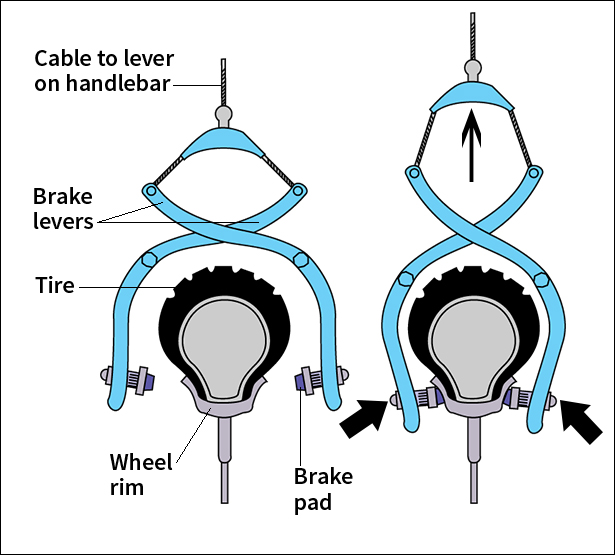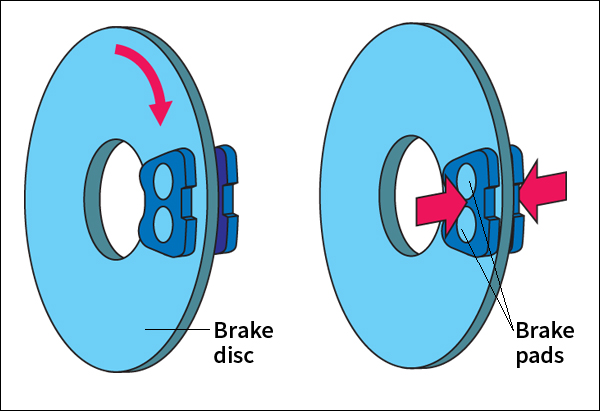Brake is a device that slows or stops a moving object. Most brakes have a part called a brake pad or brake shoe that presses against a turning wheel—or a unit connected to the wheel—to produce friction. This friction converts the wheel’s energy of motion to heat, slowing or stopping the wheel. Vehicles and industrial machines use a wide variety of brakes. This article describes brakes used chiefly in vehicles.
Vehicles are equipped with three major kinds of brakes: (1) mechanical brakes, (2) hydraulic brakes, and (3) air brakes.
Mechanical brakes
have levers or cables that force one or two pads against the wheel. Most bicycles have two mechanical brakes called caliper brakes, one for each wheel. Each brake has two small rubber pads, one on each side of the wheel rim. The pads are mounted on a mechanical device that is connected to one end of a long cable. The other end of the cable is connected to a lever on the handlebar. When the rider squeezes this lever, force on the cable presses the pads against the wheel rim.

Automobiles are equipped with another kind of mechanical brake called an emergency brake or hand brake. This brake is also known as a parking brake because it helps prevent a parked car from rolling away. When the driver applies the emergency brake, a system of levers, rods, and cables applies pressure to the pads or shoes of the rear wheels.
Hydraulic brakes
use a special liquid called brake fluid to apply brake pressure to pads or shoes. Most automobiles have a hydraulic braking system. The main parts of this system are a chamber called a master cylinder, which is located near the brake pedal; at least one wheel cylinder at each wheel; and tubes called brake lines, which connect the master cylinder to the wheel cylinders. The cylinders and brake lines are filled with brake fluid.
Inside the master cylinder is a piston, which can slide back and forth. In a simple hydraulic system, the brake pedal controls this piston by means of a rod or some other mechanical link. When the driver pushes on the pedal, the piston inside the master cylinder exerts pressure on the fluid and slides forward a short distance. The fluid transmits this pressure through the brake lines, forcing pistons in the wheel cylinders to move forward. As the wheel cylinders move forward, they apply brake pressure to pads or shoes.
The wheel cylinders are mounted in either disc brakes or drum brakes. Most cars have disc brakes on the front wheels and drum brakes on the rear wheels.
Disc brakes
have a disc, which is usually made of cast iron, attached to the vehicle’s axle. The wheel is attached to the disc. A U-shaped caliper assembly fits around a part of the disc but does not rotate with the disc. This assembly includes one or two wheel cylinders, each containing a piston and two brake pads—one on each side of the disc. The pads are flat pieces of metal lined with a heat-resistant material. When the brake is applied, the pads press inward against the disc.

Drum brakes
have a drum, usually cast iron, fastened to the axle. The wheel is attached to the drum. Inside the drum are two semicircular brake shoes that are lined with a heat-resistant material. The shoes do not rotate with the drum. Between the shoes is a wheel cylinder. This cylinder has two pistons, which push in opposite directions—one against each shoe. When the brake is applied, the shoes press outward against the drum.

Power-assisted brakes
provide additional brake pressure in most automobiles. A device called a booster is mounted between the brake pedal and the master cylinder. When the driver steps on the pedal, the booster uses the difference in pressure between the vacuum in the engine and the surrounding atmosphere to apply additional pressure to the piston in the master cylinder.
Antilock-brake systems
are installed in some automobiles to prevent wheels from locking and skidding on wet or icy roads. An antilock-brake system (ABS) includes a sensor at each wheel and a tiny computer called an electronic controller. A device known as a pressure-modulating valve assembly is mounted between the master cylinder and the wheel cylinders. Electric wires connect the sensors to the controller and the controller to the valve assembly.

The sensors send electric signals that represent wheel speed to the electronic controller. When a sensor indicates that a wheel is locking, the controller transmits a signal to the valve assembly. The assembly, in turn, applies pulses of brake pressure to the brake of the locked wheel. This pressure alternately applies and releases the brake. Pulsing continues until the wheel rotates normally.
Traction control,
available in some cars with antilock brakes, prevents wheels from slipping. When a sensor indicates slippage, the electronic controller applies brake pressure to the slipping wheel. If more than one wheel is slipping, the controller reduces engine power until the wheels stop slipping.
Air brakes
use compressed air supplied by a machine called a compressor. Most buses, heavy trucks, and trains have air brakes. When the driver or engineer applies the brakes, a storage unit releases compressed air. The air pushes against a piston or diaphragm, which applies brake pressure to pads or shoes. Buses and trucks have disc and drum brakes like those in automobiles. In trains, however, shoes press against the outside of the wheel.
